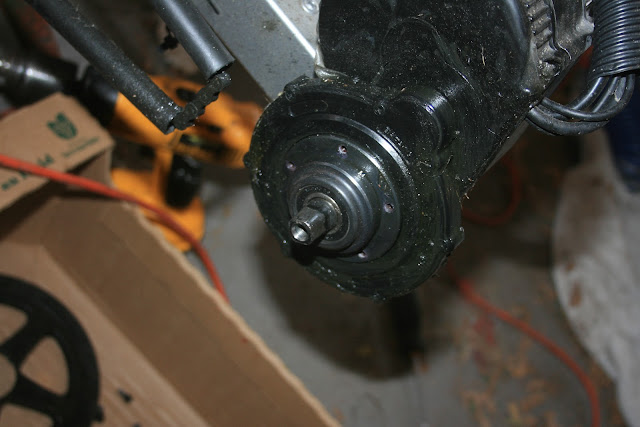I removed the unit and the actuator arm was 'sticky and crunchy'. I pulled it apart as far as I could get it and prepared to order a new set of Avid BB7s. My first search on Amazon for same came up with a 'good as Avid BB7 replacement brake set' only 28 bucks delivered for both complete w new rotors. A few dozen positive reviews and one very negative. What the heck $28 vs $135 for the genuine Avid BB7s. What could possibly go wrong.
 |
| The new AfterPartz disk rotor and caliper installed (and ready to fail) and the wheel back in place |
The delivery was prompt. The contents of the box looked good. But there was no instructions and no link to same to be found. No problem I plunged on ahead. A disk brake set is a disk brake set, right? I looked at the Avid sight for BB7s and BB5s and followed along. Put on the rotor... no problem. The hardware for the caliper mount was identical to what the Alhonga used... seems standard on all disks and most kits come with two different sets of mounts depending on configuration. Mounted up, adjusted, and hooked up the cable.
Time to test, Spin the wheel, apply the brake and 'click!' The actuator arm moves forward and tension applied to the disk is lost. Spent a half day trying to figure out why. Gave up in disgust and installed the other caliper. Seemed okay, took for ride next morning after 5km, 'Click!' No pressure on disk.. Disconnected cable, fiddled with actuator arm, seemed to reset. Reconnected cable readjusted and resumed ride. After 45 km, pulling into the elevator lobby at the condo, 'Click!' No brakes.
There followed a whole series of emails with the supplier, Amazon and vendor AfterPartz. Someplace in there I gave up and ordered a set of Avid BB7s again from Amazon. They arrived promptly and I installed per their excellent series of YouTube videos ( pretty much the same procedure as used on the AfterPartz. The Avid BB7s worked flawlessly. Beautifully modulated and effective.
AfterPartz had offered several times to send me a replacement set, a discount, or a refund (No need to return the original set). I accept the refund.
Curiosity had to be satisfied. I took the AfterPartz units apart several time to see if I could determine why they failed to work. It is easy to disassembleThe following points were noted:
- There were traces of 'tramp' material inside the body of the caliper, that was probably preventing the ridge on the inside ramp from mating firmly with the notch in the caliper body. This ridge/notch keeps the inside ramp from rotating. Rotation would cause the bearings in the actuation ramp to slip back into neutral position.
- If the actuator arm was applied too fully without a disc inserted between the pads, it could again cause the ridge in the bottom ramp to slip out of the notch in the body causing slippage.
- There is no lubricant inside the caliper mechanism. What does that portend to service life?
- There are no thrust bearings in the mechanism.
 |
| The guts of the Alhonga Caliper: Complex engineering and a bear to reassemble. I may do that when I'm home in the spring. Sorry about picture quality! |
The Alhonga Caliper, I did manage to finally disassemble it. It is quite impressive internal engineering with a ball bearing w cage between two races for a thrust bearing. It was well lubricated and no noticeable corrosion. I suspect the failure is the surface of the cam ramps or the ball bearings that roll on them but I need a magnifying glass to examine. These peepers just aren't up to it unaided.
My new brakes are all installed, run in and with even a fresh set of cables. So I am no longer screaming warnings as other pedestrians, pets, and cyclists scatter when I approach.
Ride on!
































